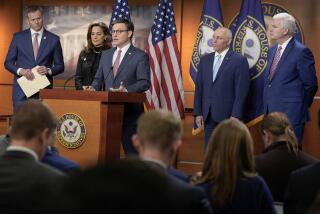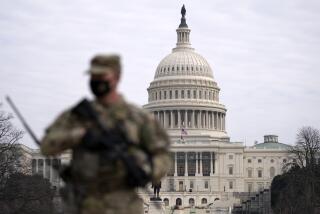House Strongly Backs Arming of Pilots in Airline Cockpits
- Share via
WASHINGTON — Airline pilots with semiautomatic pistols would be able to defend the cockpit against terrorist attack under legislation passed overwhelmingly by the House on Wednesday.
But prospects that the bill will become law remained uncertain because of opposition from the airline industry, concerns at the Transportation Department and skepticism in the Senate.
The House vote was 310-113, but in the Senate, Commerce Committee Chairman Ernest F. Hollings (D-S.C.) remains steadfastly opposed, said his spokesman, Andy Davis.
“Where this goes from here is hard to tell,” said Davis. “The White House doesn’t support it. The Transportation Department doesn’t support it.”
During Wednesday’s House debate, lawmakers rejected a compromise that would have limited the program to 1,400 volunteer “federal flight deck officers” over a two-year test period. Instead, by a vote of 250-175, they approved an amendment by Rep. Peter A. DeFazio (D-Ore.) to make the program permanent and open it to any pilot volunteer qualified to undergo training.
The House vote was a clear victory for pilot unions, which lobbied hard for legislation that would allow their members to carry guns. That military jets can now bring down hijacked civilian airliners proved to be a convincing argument for arming pilots.
“Today, armed F-16s are prepared to shoot down any commercial jet that is hijacked by terrorists,” said House Transportation Committee Chairman Don Young (R-Alaska). “Under these new circumstances, we must allow trained and qualified pilots to serve as the last line of defense.”
But the airlines fear that giving pilots guns could lead to accidental shootings and lawsuits from passengers. The flight attendant union also opposes arming pilots, worried that its members could become unintended victims in a high-altitude shootout.
Some airlines are advocating stun guns as an alternative to bullets. United Airlines has purchased more than 1,300 of the devices and has begun training its pilots. But the Transportation Security Administration and the Federal Aviation Administration do not appear to be close to deciding on whether to permit their use.
After the Sept. 11 terrorist attacks on New York and the Pentagon, the government and the airlines took steps to reinforce cockpit doors. Temporary metal bars were installed, and the doors themselves are being replaced with ones designed to be bulletproof. Senate supporters of arming pilots, frustrated by Hollings’ opposition, said the House vote will help their legislation. They are looking for another bill to attach it to on the Senate floor.
The House action “demonstrates that the best way to fight terrorism is not with toys but with handguns,” said Eric Bovim, a spokesman for Sen. Conrad R. Burns (R-Mont.). “This sends a message to the Senate and to the administration.”
Burns, a conservative, won an unlikely ally Wednesday when Sen. Barbara Boxer (D-Calif.) endorsed the Senate version of the bill. A leading liberal, Boxer found herself in the company of Burns and Sen. Bob Smith (R-N.H.), another conservative.
“I think this is the first time I have ever stood with Sen. Smith on an issue that has involved guns,” Boxer said. “However, I have decided that until I am satisfied with the number of air marshals on commercial flights, this bill ... is a matter of life and death.”
The number of air marshals is classified, but it has been greatly increased from the 32 who were available on Sept. 11--all assigned to international flights. Experts estimate that it would take about 120,000 marshals to cover every flight, at an estimated cost of more than $10 billion a year.
The fact that marshals can only protect a small proportion of flights is one of the main arguments for training and arming pilots, said Rep. John L. Mica (R-Fla.), one of the authors of the House bill. Mica said the pilots would not be allowed to leave the cockpit and engage attackers in the passenger cabin. Instead, their weapons could be used solely to repel an attack on the cockpit.
In the aviation security bill passed last year, Congress authorized the arming of pilots but left the decision to the Transportation Department. After considering the issue, department officials decided that the potential risks outweighed the possible benefits.
If the House bill becomes law, it’s unclear how quickly its provisions could be carried out.
Among the issues to be resolved is how to pay for the pilot training. Congressional analysts had estimated that a limited program for 1,400 pilots would cost $47 million over five years, but there is no estimate for an open-ended program such as the House approved. Also unclear is whether the airlines would challenge the congressional mandate as an unwarranted intrusion into their businesses.
“This legislation has a fatal flaw: We don’t give the airlines a choice on whether their employees can carry guns on their planes,” said Rep. Vernon J. Ehlers (R-Mich.). “The federal government should not mandate that a reluctant airline should allow a pilot to carry a gun. I am not aware of any instance where the federal government has told employees they can carry guns to work.”
More to Read
Sign up for Essential California
The most important California stories and recommendations in your inbox every morning.
You may occasionally receive promotional content from the Los Angeles Times.










